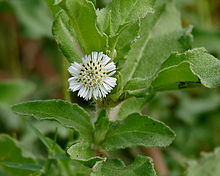
Hordeum is a genus of annual and perennial plants in the grass family. They are native throughout the temperate regions of Africa, Eurasia, and the Americas.
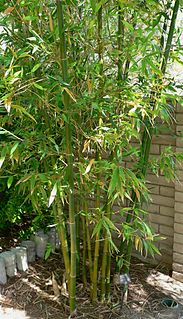
Bambusa is a large genus of clumping bamboos. Most species of Bambusa are rather large, with numerous branches emerging from the nodes, and one or two much larger than the rest. The branches can be as long as 11 m (35 ft).
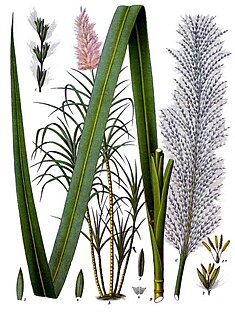
Saccharum is a genus of tall perennial plants of the broomsedge tribe within the grass family.

Nothoscordum is a genus of New World plants in the onion tribe within the Amaryllis family. It is probably paraphyletic. The genus is native to North and South America, though a few species have become naturalized in various parts of the Old World.

Ajuga, also known as bugleweed, ground pine, carpet bugle, or just bugle, is a genus of 40 species annual and perennial herbaceous flowering plants in the Ajugeae tribe of the mint family Lamiaceae, with most species native to Europe, Asia, and Africa, but also two species in southeastern Australia. They grow to 5–50 cm tall, with opposite leaves.

Ocimum is a genus of aromatic annual and perennial herbs and shrubs in the family Lamiaceae, native to the tropical and warm temperate regions of all 6 inhabited continents, with the greatest number of species in Africa. It is the genus of basil and the name is from the Ancient Greek word for basil, ὤκιμον (ṓkimon). Its best known species are the cooking herb cooking basil, O. basilicum and the medicinal herb tulsi, O. tenuiflorum.

Pennisetum is a widespread genus of plants in the grass family, native to tropical and warm temperate regions of the world. They are known commonly as fountaingrasses. Pennisetum is considered a synonym of Cenchrus in Kew's Plants of the World Online.

Casuarina is a genus of 17 tree species in the family Casuarinaceae, native to Australia, the Indian subcontinent, southeast Asia, islands of the western Pacific Ocean, and eastern Africa. It was once treated as the sole genus in the family, but has been split into four genera.
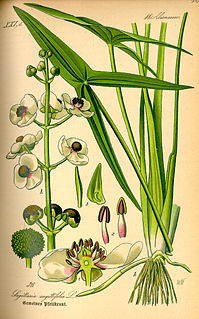
Sagittaria is a genus of about 30 species of aquatic plants whose members go by a variety of common names, including arrowhead, duck potato, katniss, Omodaka, swamp potato, tule potato, and wapato. Most are native to South, Central, and North America, but there are also some from Europe, Africa, and Asia.

Schoenoplectus is a genus of plants in the sedges with a cosmopolitan distribution. Note that the name bulrush is also applied to species in the unrelated genus Typha as well as to other sedges. The genus Schoenoplectus was formerly considered part of Scirpus, but recent phylogenetic data shows that they are not closely related.
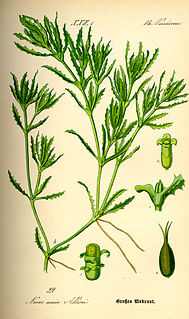
Najas, the water-nymphs or naiads, is a genus of aquatic plants. It is cosmopolitan in distribution, first described for modern science by Linnaeus in 1753. Until 1997, it was rarely placed in the Hydrocharitaceae, and was often taken as constituting the family Najadaceae.

Eclipta prostrata commonly known as false daisy, yerba de tago, Gunta kalagaraku/Gunta galagaraku, Karisalankanni, and bhringraj, is a species of plant in the sunflower family. It is widespread across much of the world.

Bothriochloa is a common and widespread genus of plants in the grass family native to many countries on all inhabited continents and many islands. They are often called beardgrass, bluegrass or bluestem.
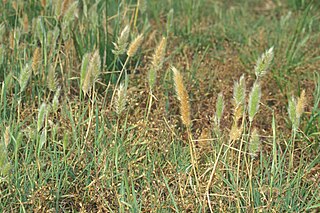
Polypogon is a nearly cosmopolitan genus of plants in the grass family, commonly known beard grass or rabbitsfoot grass.

Spermacoce or false buttonweed is a genus of flowering plants in the family Rubiaceae. It comprises about 275 species found throughout the tropics and subtropics. Its highest diversity is found in the Americas, followed by Africa, Australia and Asia.

Eleusine is a genus of Asian, African, and South American plants in the grass family, sometimes called by the common name goosegrass. One species (Eleusine indica), is a widespread weed in many places. Another species Eleusine coracana, is finger millet, cultivated as a cereal grain in India and parts of Africa.

Themeda is a genus of plants in the grass family native to Asia, Africa, Australia, and Papuasia. There are about 18 to 26 species, many of which are native to Southeast Asia.

Eustachys is a genus of tropical and subtropical plants in the grass family. It is native primarily to warmer parts of the Americas, with a few species in Africa and Asia.

Gamochaeta is a genus of flowering plants in the aster family. There has not always been agreement among botanists regarding its status as a recognized genus, but it has become more accepted in recent years. It currently includes many plants that previously belonged in genus Gnaphalium. Like many species of Gnaphalium, many Gamochaeta are called cudweeds or everlastings.
